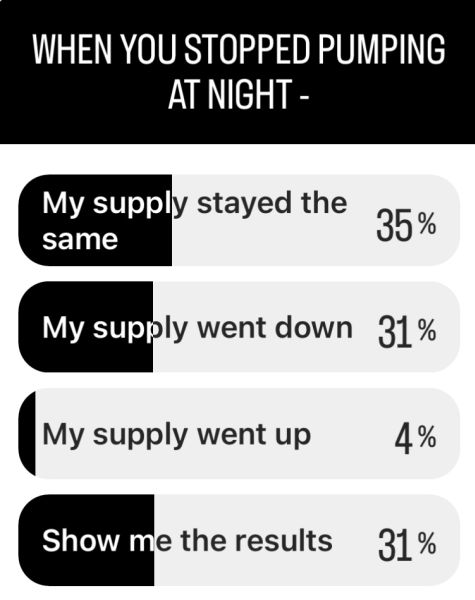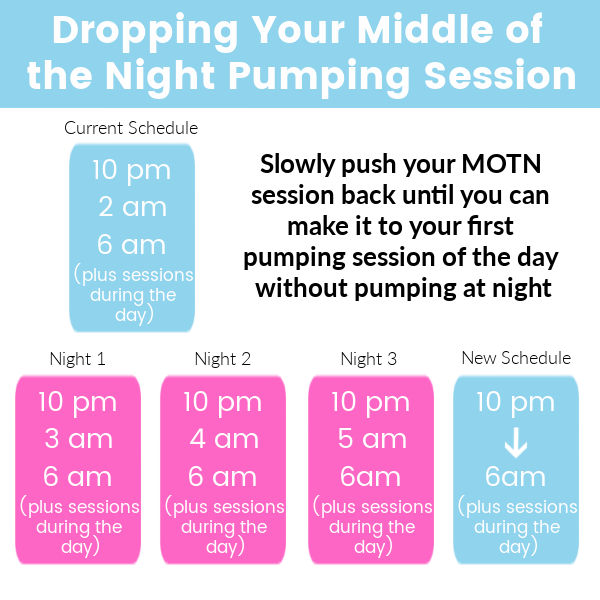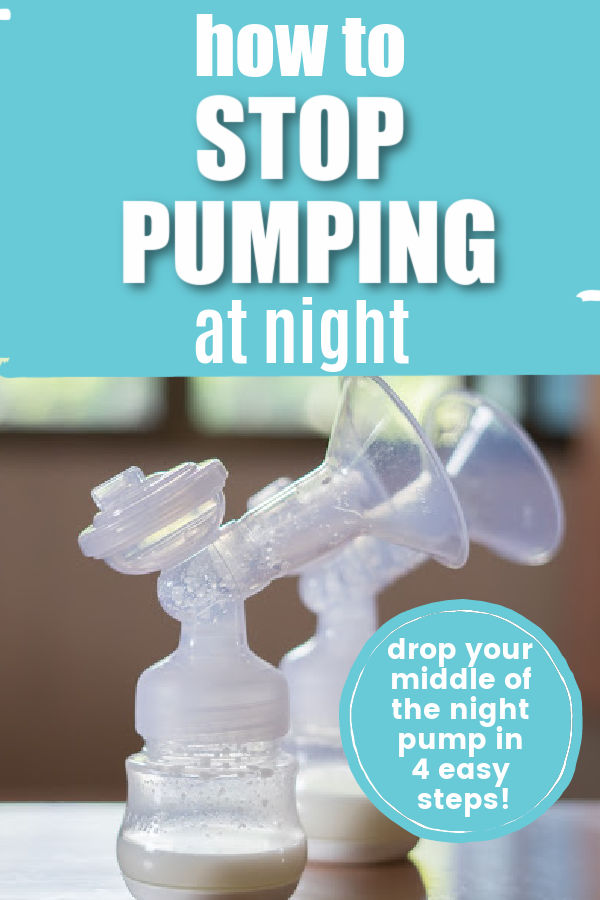Once your baby starts sleeping for longer stretches, you might wonder how to stop pumping at night. Here’s a step by step plan for how to drop middle of the night pumping sessions, including what you should do if you’re prone to clogged milk ducts, and whether you should worry about your milk supply.

This post may contain affiliate links, which means if you click a link and purchase something, I may make a small commission at no additional cost to you. I only recommend products I love! More information here.
Concerns about Dropping Middle of the Night Pumping Sessions
When you’re thinking “when can I stop pumping at night?” the two most common concerns are usually 1) milk supply and 2) clogged ducts.
Here’s what to consider when dropping your middle of the night session (also known as the MOTN pump).
1. Will my milk supply go down?
Unfortunately, there’s no way to know for sure. Anything can happen when you drop a pumping session – your supply might drop, it might stay the same, or it might even increase due to the extra sleep you’re getting.
Below is an unscientific poll I did on Instagram (about 3,000 responses):

Your best bet to mitigate the risk of losing supply when dropping a pumping session is to add the time from the dropped session back to your remaining pumping sessions, so that your total pumping time in a day stays the same.
There are a few factors regarding dropping the middle of the night pumping session that may affect milk supply.
Prolactin levels
One risk has to do with prolactin.
Many people notice that they pump more milk in the early morning hours (between 1am and 6am) than they do later in the day.
Because prolactin levels are higher at night than they are during the day, the concern is that by not expressing milk during this time, you might miss out on an extra boost of milk. Over time, this could affect your overall milk supply.
This doesn’t always happen, though. I personally did not lose any supply when I dropped my middle of the night session; I just got more milk in the mornings.
However, as I said above, everyone is different. It’s a good idea to monitor this as you drop your night time session and immediately afterward. If you notice your supply dropping, you may want to weigh the benefits (sleep) with the risks (less milk) of continuing.
Return of menstruation
Another risk is that after you drop your middle of the night pumping session, your period will come back.
Breastfeeding frequency is an important factor in fertility after having a baby. If you stop pumping overnight, your period may come back sooner than it would have if you hadn’t because of the reduced frequency in lactation.
Menstruation is sometimes associated with a loss in milk supply, though there are some steps you can take to try to minimize or prevent this.
2. What if I’m prone to clogged ducts?
Dropping a pumping session – especially the middle of the night one, where you’ll be going longer between pumping sessions than you have before – can be really scary if you’ve had clogged milk ducts or mastitis before.
Here are a few extra steps that you can take if you’re prone to clogged ducts:
Go slowly
In the step by step plan below, I explain how to drop your middle of the night pumping session quickly and how to do it at a slower pace. You should pick the slower pace.
Consider lecithin

Lecithin may help make your milk less sticky, which also makes it less likely you’ll get a plugged milk duct.
Consider starting lecithin before you start dropping the pumping session.
More or less “empty” your breasts at the sessions before and after
Try to “empty” your breasts at the session before the one you’re dropping (in most cases, the last one before bed) and the next one (your second middle of the night session or the first one in the morning). This might mean pumping a little longer at these sessions.
(I say more or less because it’s not possible to ever completely empty your breasts, as they are always making milk.)
Need help with exclusive pumping? Use EPUMP30 for 30% off
The best way to drop a middle of the night pumping session
There are four ways to drop pumping sessions, which you can read more about here.
For dropping middle the night sessions, I prefer the fourth method, where you move pumping sessions until they are closer together and you can drop one of the them.
The goal here is to slowly move the pumping session back until you get close enough to either the next middle of the night session or the first morning session that you can drop one of the sessions.
This is because usually, when you’re dropping a night time session, you’re training your breasts to go longer between pumping sessions than they have before. It’s best to do that slowly to allow your body to adjust.
Step by step plan for how to drop middle of the night pumping sessions
Here is how to drop the middle of the night pumping session in four easy steps.
1. Write down your current pumping schedule.
If you have a firm schedule – like 9am, 1pm, 5pm, 9pm, 1am, 5am – you can skip this step.
This step is for those who pump at night whenever their babies get up to eat, or who pump a certain number of hours from their last pumping session. The idea here is to understand where you’re at, so that you can plan the changes that you’re going to make.
Example
So let’s say that you pump every three hours during the day plus whenever your baby wakes up at night. Most nights, that’s once, somewhere between 2:30am and 4:30am. You go to bed around 10pm, and you start your last session of the day at 9:30pm. You get up for the day at 7am and pump shortly afterwards.
Your schedule would look something like this:
3:30am, 7:30am, 10:30am, 1:30pm, 4:30pm, 7:30pm, 9:30pm
These may not always be the exact times that you pump, but it gives you a good idea of where you’re at now, so you can plan how to get where you want to be.
2. Decide what you want your new schedule to be.
Make sure that your goal is clear. How long do you want to be able to go without pumping at night?
Let’s say that you decide you want to be able to go from 10pm to 6am without pumping, and pump every three hours during the day.
Example
Your goal schedule might look something like this:
6am, 9am, 12pm, 3pm, 6pm, 9:30pm
In practice, you wouldn’t have to pump at exactly these times; maybe you push back the 9am to 10am on Mondays because of an activity or something. That’s totally fine, we just want a general plan to work towards.
3. Make a plan for dropping the middle of the night session.
So you’ve identified the pumping session that you are going to push back (in our example, 3:30am), and your next pumping time in your goal schedule (6am). The next thing that you need to figure out is how much time you want to push the session back at once.
You might be able to push back an hour at a time. If you’re prone to clogs, you might want to do 15 or 30 minutes.
Example
Let’s say you decide on 30 minutes at a time.
You could push the 3:30am session back by 30 minutes per day until you get close enough to 6am that you can drop the session altogether.
That would look something like this:
- On the first day, you’d go until 4am
- On the second day, to 4:30am
- On the third day, to 5am
- On the fourth day, to 5:30am
- On the fifth day, to 6am, and you’re on your new schedule
(Note: at some point, probably around the 5am or 5:30am mark, it won’t make sense to pump again at 6am. At that point, you can drop the session, add the pumping time back to your remaining sessions, and just continue to keep pushing the time back until you get to your target time of 6am.)
Does that seem too slow? You can go faster! Maybe you want to push the time back an hour a day. Or two hours a day. Whatever you think your body can handle is fine.
Or does that seem too fast? Maybe you’ve tried pushing sessions back before and you got mastitis. Go slower! You can do 15 minutes at a time, and wait a few days at the new time before pushing back another 15 minutes.
Set the pace that you think is best for your body.
Below is a visual example of how this might look.

4. Start dropping your middle of the night session – and keep track of what happens!
Once you’ve got your plan, you can go ahead and get started pushing your sessions back.
It’s a good idea to use either a pumping app or just a piece of paper and a pen to track when you’re pumping and your output. This allows you to troubleshoot potential issues, and proactively identify any changes in supply so you can make adjustments if needed.
Have suggestions or questions? Leave them in the comments!
References
- Battin, DA., et al. “Effect of suckling on serum prolactin, luteinizing hormone, follicle-stimulating hormone, and estradiol during prolonged lactation.” https://www.ncbi.nlm.nih.gov/pubmed/3923412?dopt=Abstract
- Bonyata, Kelly, IBCLC. “Breastfeeding and Fertility.” https://kellymom.com/ages/older-infant/fertility/



















